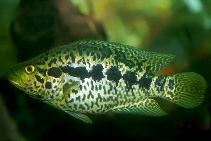| Family: |
Cichlidae (Cichlids), subfamily: Cichlasomatinae |
| Max. size: |
55 cm TL (male/unsexed); max.weight: 1,580.0 g |
| Environment: |
benthopelagic; freshwater; pH range: 7 - 8.69999980926514; dH range: 10 - 15; depth range 3 - 10 m |
| Distribution: |
Central America: Atlantic slope from the Ulua River (Honduras) to the Matina River (Costa Rica). |
| Diagnosis: |
Dorsal spines (total): 17-18; Dorsal soft rays (total): 10-11; Anal spines: 6-8; Anal soft rays: 11-12. This species is distinguished by its large mouth, projecting lower jaw, prominent enlarged canine teeth, black spots on fins and body, a more or less continuous black stripe between the eye and opercular margin, another between the eye and the lower angle of the opercle; a row of black blotches along the middle of the side. Distinguished from other members of the genus by having the preopercle expanded at the angle. Body color silvery or golden-green to purple; back moss green, sides with purple iridescence, belly whitish or yellowish; dorsal, anal and caudal fins with numerous black spots, interspaces whitish, yellowish or with blue iridescence; a black blotch on the caudal-fin base. Breeding females with stronger crimson hue to the gill cover. |
| Biology: |
Inhabits lakes, preferring turbid waters and mud bottoms of the highly eutrophic lakes (Ref. 7335). Found in springs and ponds over detritus and sand bottom (Ref. 5723). Commonly found in very warm, oxygen depleted inundation lakes (Ref. 8978). Highly predaceous, feeding mainly on small fishes and macroinvertebrates (Ref. 7335; 44091). Oviparous, spawns in batches (Ref. Highly esteemed as food fish (Ref. 44091). Maximum length 63 cm TL (Ref. 5723). |
| IUCN Red List Status: |
Least Concern (LC); Date assessed: 05 February 2020 Ref. (130435)
|
| Threat to humans: |
potential pest |
Source and more info: www.fishbase.org. For personal, classroom, and other internal use only. Not for publication.

